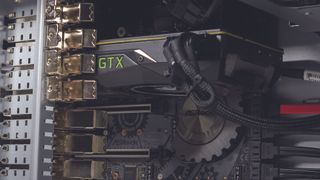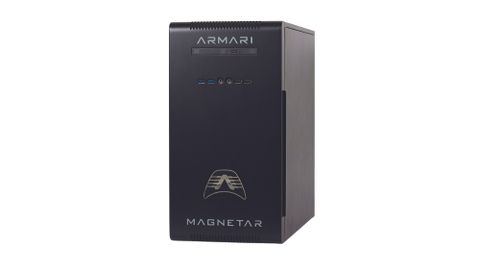IT Pro Verdict
The Armari Magnetar S16T-RW1000G2 is a capable all-rounder; just note its 3D modelling abilities depend on the software you are running. You'll have to shell out a fair amount to get your hands on it, but your investment will be rewarded with some serious hardware power.
Pros
- +
Incredibly speedy rendering performance; Optane storage is blazing fast
Cons
- -
Expensive; Titan Xp isn't an officially-supported enterprise card; Modelling performance is dependent on the applications
This Armari workstation is unusual for a number of reasons. The primary one is that the Magnetar is one of the few workstations currently available that's based around the AMD Ryzen Threadripper processor rather than anything from Intel's increasingly confusing range. Second, Nvidia supplies the graphics power, but not through a Quadro. And third, this is our first taste of Intel's much-discussed Optane memory.
The Magnetar includes the top-end AMD Threadripper 1950X, which has a nominal 3.4GHz clock speed, 16 cores and 32 threads. Armari has permanently set the processor to 4GHz across all cores, with an Enermax watercooling system to keep temperatures down. The CPU is partnered by 64GB of DDR4 SDRAM, which is running at 3,333MHz.
Instead of Nvidia Quadro graphics, Armari opts for a GeForce GTX chip. However, this isn't such an outlandish choice, particularly for games designers. The GeForce GTX in question is the Titan Xp, which is the most recent spin on Nvidia's superlative gaming chip. Crucially, back in August 2017 Nvidia released drivers for the Titan that include optimisation for professional applications.
This doesn't make the Titan Xp a supported card, but it will mean that the GPU's huge performance can be made available. This is considerable, because the Titan Xp has a massive 3,840 CUDA cores and 12GB of GDDR5X memory with a class-leading 547.7GB/sec of bandwidth, so it has plenty to offer GPU-based rendering as well.
Another star of the show is the Intel Optane NVMe solid state disk, supplied for operating system and application duties. This is the 900P model, with a 480GB capacity. Optane is Intel's branding for 3D Xpoint Flash memory, which works in a different way to NAND or NOR types. The NAND type is the dominant one in most SSDs, but it suffers from significantly slower write speeds when writing, and has a limited number of read-write cycles. The design of Optane means it's almost as fast for writing as it is for reading, and has a much longer lifespan rating.

Looking at the performance scores, the Intel Optane doesn't offer the very fastest speeds for reading data, but it is very quick. For writing, however, it's leagues ahead of most of its competition - by a clear 500MB/sec in some cases. However, Intel Optane memory is still quite a bit more expensive than a regular SSD, so Armari still includes a 4TB conventional 7,200rpm hard disk for general storage. That's a generous capacity, but the Western Digital Gold Datacenter is a merely average performer compared to more impressive rivals. The final storage ingredient is a slimline DVD writer.
The Armari's 16 cores and 32 threads running at 4GHz make it a rendering powerhouse. Its score of 3,449 in the Maxon Cinebench R15 CPU test is incredibly good, and not far off the best of the bunch. Similarly, the Blender render duration of 1,406 seconds puts it among the top performers, as does a score of 500 in our own benchmarks. However, although the GeForce GTX Titan Xp was the clear leader for raw OpenCL grunt in LuxMark 3.1, it fell behind the AMD Radeon Pro WX9100 and Nvidia GeForce GTX 1080 Ti with the Blender render, taking a long time to initialise the scene. Still, this remains an impressive card for CUDA- or OpenCL-accelerated rendering in general.
The Armari also proved itself very capable with the Adobe Media Encoder, taking 202 seconds with GPU support and 297 seconds without. Modelling performance is a mixed bag, however, with a low result in Maxon Cinebench R15 OpenGL and SPECviewperf 12.1's SolidWorks, but the fastest with Siemens NX and the showcase-01 viewset. The score with 3ds Max was second fastest, whilst Catia, medical-01 and energy-01 were top.
Overall, the Armari Magnetar S16T-RW1000G2 is a capable all-rounder; just note its 3D modelling abilities depend on the software you are running. You'll have to shell out a fair amount to get your hands on it, but your investment will be rewarded with some serious hardware power.
Verdict
The Armari Magnetar S16T-RW1000G2 is a capable all-rounder; just note its 3D modelling abilities depend on the software you are running. You'll have to shell out a fair amount to get your hands on it, but your investment will be rewarded with some serious hardware power.
Dr James Morris has worked as a technology journalist for over 25 years, including spending nine years on the staff of market-leading computer magazine PC Pro, the last five of which were as the publication’s editor. He specialises in enterprise-grade software and hardware, with a particular focus on content creation. He launched a pioneering video channel for HEXUS.net in 2006 and ran the video reviews channel for TrustedReviews.com for four years. He also runs a successful online digital content and commercial video production company, t-zero communications Ltd.
Dr Morris is a prolific technology writer and contributes commercial content for major IT brands including AMD, BlackBerry, Dell, Cognizant, HP, and IBM. He published a book on artificial intelligence, Can Computers Create Art? in 2009. He is also an academic, and is currently Pathway Director of the MA, Interactive Journalism at City, University of London.
Previously, he was course leader for the BA in Web Media Production at Ravensbourne University. He has a PhD in Philosophy, Art and Social Thought from the European Graduate School in Switzerland, a Master's in Media Arts from the New School in New York, USA, and a Bachelor's in Social Anthropology from the London School of Economics.
Dr. Morris can be found on Twitter at @Cyberwest, or emailed at j@tzero.co.uk



